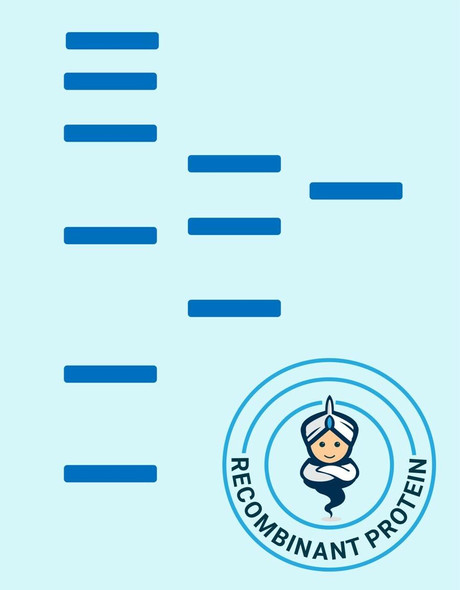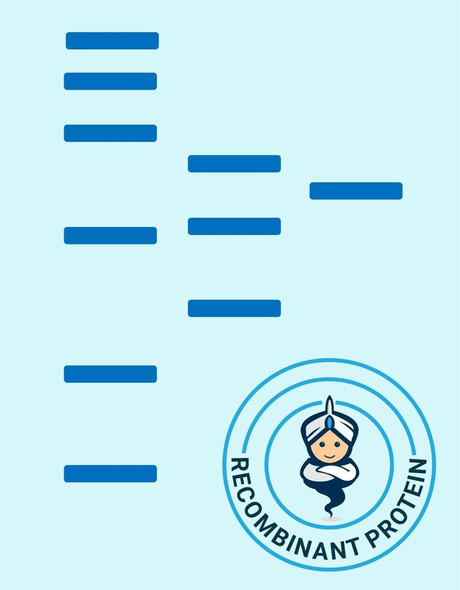Human Glucagon Recombinant Protein (RPPB1278)
- SKU:
- RPPB1278
- Product type:
- Recombinant Protein
- Size:
- 20ug
- Species:
- Human
- Target:
- Glucagon
- Synonyms:
- Glucagon
- GCG
- GLP1
- GLP2
- Source:
- Escherichia Coli
- Uniprot:
- P01275
Description
| Product Name: | Human Glucagon Recombinant Protein |
| Product Code: | RPPB1278 |
| Size: | 20µg |
| Species: | Human |
| Target: | Glucagon |
| Synonyms: | Glucagon, GCG, GLP1, GLP2, GRPP. |
| Source: | Escherichia Coli |
| Physical Appearance: | Sterile filtered colorless solution. |
| Formulation: | Glucagon protein solution (0.5mg/ml) containing 20mM Tris-HCl buffer (pH 8.0), 1mM DTT, 50% glycerol and 0.2M NaCl. |
| Stability: | Store at 4°C if entire vial will be used within 2-4 weeks. Store, frozen at -20°C for longer periods of time. For long term storage it is recommended to add a carrier protein (0.1% HSA or BSA).Avoid multiple freeze-thaw cycles. |
| Purity: | Greater than 95.0% as determined by SDS-PAGE. |
| Amino Acid Sequence: | MGSSHHHHHH SSGLVPRGSH MKRHDEFERH AEGTFTSDVS SYLEGQAAKE FIAWLVKGRG RRDFPEEVAI VEELGRRHAD GSFSDEMNTI LDNLAARDFI NWLIQTKITD RK |
Glucagon is an important hormone involved in carbohydrate metabolism. The hormone is synthesized and secreted from alpha cells (a-cells) of the islets of Langerhans, which are located in the endocrine portion of the pancreas. Glucagon is released when the glucose level in the blood is low (hypoglycemia), causing the liver to convert stored glycogen into glucose and release it into the bloodstream. The action of glucagon is thus opposite to that of insulin, which instructs the body's cells to take in glucose from the blood in times of satiation.Glucagon is beneficial for the culture of some cell types. It has been used in some biochemical regulation studies of glycogenolysis in hepatocytes. It has been also been found to induce DNA replication in primary cultures of adult rat hepatocytes when used in combinations with EGF and Insulin. Glucagon increases the blood glucose concentration by promoting rapid breakdown of liver glycogen, and also acts to relax smooth muscle such as the gastrointestinal tract.
Glucagon Human Recombinant produced in E.Coli is a single, non-glycosylated polypeptide chain containing 112 amino acids (90-180 a.a.) and having a molecular mass of 12.8kDa.Glucagon is fused to a 21 amino acid His-tag at N-terminus & purified by proprietary chromatographic techniques.
| UniProt Protein Function: | GCG: Glucagon plays a key role in glucose metabolism and homeostasis. Regulates blood glucose by increasing gluconeogenesis and decreasing glycolysis. A counterregulatory hormone of insulin, raises plasma glucose levels in response to insulin-induced hypoglycemia. Plays an important role in initiating and maintaining hyperglycemic conditions in diabetes. Glucagon release is stimulated by hypoglycemia and inhibited by hyperglycemia, insulin, and somatostatin. GLP-1 and GLP-2 are induced in response to nutrient ingestion. Glucagon is secreted in the A cells of the islets of Langerhans. GLP-1, GLP-2, oxyntomodulin and glicentin are secreted from enteroendocrine cells throughout the gastrointestinal tract. GLP1 and GLP2 are also secreted in selected neurons in the brain. Belongs to the glucagon family. |
| UniProt Protein Details: | Protein type:Secreted, signal peptide; Secreted; Hormone Chromosomal Location of Human Ortholog: 2q36-q37 Cellular Component: extracellular space; endoplasmic reticulum lumen; extracellular region; plasma membrane Molecular Function:identical protein binding; protein binding; hormone activity; glucagon receptor binding; receptor binding Biological Process: positive regulation of protein binding; positive regulation of histone H3-K4 methylation; signal transduction; positive regulation of peptidyl-serine phosphorylation; G-protein signaling, coupled to cAMP nucleotide second messenger; response to starvation; G-protein coupled receptor protein signaling pathway; cell proliferation; cellular protein metabolic process; positive regulation of protein kinase activity; positive regulation of cAMP biosynthetic process; energy reserve metabolic process; feeding behavior; regulation of insulin secretion; negative regulation of apoptosis |
| NCBI Summary: | The protein encoded by this gene is actually a preproprotein that is cleaved into four distinct mature peptides. One of these, glucagon, is a pancreatic hormone that counteracts the glucose-lowering action of insulin by stimulating glycogenolysis and gluconeogenesis. Glucagon is a ligand for a specific G-protein linked receptor whose signalling pathway controls cell proliferation. Two of the other peptides are secreted from gut endocrine cells and promote nutrient absorption through distinct mechanisms. Finally, the fourth peptide is similar to glicentin, an active enteroglucagon. [provided by RefSeq, Jul 2008] |
| UniProt Code: | P01275 |
| NCBI GenInfo Identifier: | 125987831 |
| NCBI Gene ID: | 2641 |
| NCBI Accession: | P01275.3 |
| UniProt Secondary Accession: | P01275,Q53TP6, A6NN65, |
| UniProt Related Accession: | P01275 |
| Molecular Weight: | 20,909 Da |
| NCBI Full Name: | Glucagon |
| NCBI Synonym Full Names: | glucagon |
| NCBI Official Symbol: | GCG |
| NCBI Official Synonym Symbols: | GLP1; GLP2; GRPP |
| NCBI Protein Information: | glucagon; preproglucagon; glucagon-like peptide 1; glucagon-like peptide 2; glicentin-related polypeptide |
| UniProt Protein Name: | Glucagon |
| UniProt Synonym Protein Names: | Incretin hormone |
| Protein Family: | Glucagon |
| UniProt Gene Name: | GCG |
| UniProt Entry Name: | GLUC_HUMAN |










